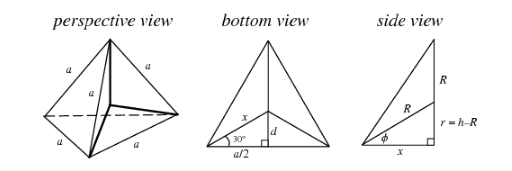
The inradius of a regular tetrahedron of side length a is
A. $ \sqrt {\dfrac{2}{3}a} $
B. $ \sqrt {\dfrac{3}{2}a} $
C. $ \dfrac{a}{{\sqrt 6 }} $
D. $ \dfrac{a}{{2\sqrt 6 }} $
Answer
551.1k+ views
Hint: In the problem they have asked to find the inradius of a regular tetrahedron. Let the side length of a tetrahedron be $ a $ , and let its base lie in the plane $ z = 0 $ with one vertex lying along the positive $ x $ axis. Thereafter, assuming the inradius and the circumference to be $ r $ and $ R $ respectively.
Complete step-by-step answer:

ording to the given information, we have,
Side length of a tetrahedron is $ a $ .
Let its base lie in the plane $ z = 0 $ with one vertex lying along the positive $ x $ axis. Assuming the inradius and the circumference to be $ r $ and $ R $ respectively and also the height and area to be $ h $ and $ A $ respectively.
Then the polyhedron vertices of this tetrahedron are located at ( $ x,0,0 $ ), ( $ - d, \pm \dfrac{a}{2},0 $ ), and ( $ 0,0,h $ ), where,
\[ \Rightarrow x = \dfrac{{\dfrac{a}{2}}}{{\cos (\dfrac{\pi }{6})}}\] $ = \dfrac{1}{3}\sqrt {3}a $
Thereafter on simplifying ‘ $ d $ ’ we get,
$ \Rightarrow d = \sqrt {{x^2} - {{(\dfrac{1}{2}a)}^2}} $ $ = \dfrac{1}{6}\sqrt {3}a $
This further gives the area of the base as,
$ \Rightarrow A = \dfrac{1}{2}a(R + x) $ $ = \dfrac{1}{4}\sqrt 3 {a^2} $
Therefore we get the height of the tetrahedron to be,
\[ \Rightarrow h = \sqrt {{a^2} - {x^2}} \] $ = \dfrac{1}{3}\sqrt 6 a $
Further, the circumference of the tetrahedron is calculated from,
$ {x^2} + {(h - R)^2} = {R^2} $
$ {x^2} + {h^2} - 2hR + {R^2} = {R^2} $
Now on substituting the values already calculated in the above given equation we get,
$ \Rightarrow R = \dfrac{{{x^2} + {h^2}}}{{2h}} $
$ \Rightarrow \dfrac{1}{4}\sqrt 6 a $
Finally, we calculate the inradius $ r $ from,
$ r = h - R $
$ \Rightarrow \dfrac{1}{{12}}\sqrt 6 a $ $ = \dfrac{a}{{2\sqrt 6 }} $
So, the correct answer is “Option D”.
Note: Tetrahedron is the simplest of the entire ordinary convex polygon and the only one which has fewer than five faces (four faces). The tetrahedron has 7 axes of symmetry: $ ^4{C_3} $ (axes connecting vertices with the centers of the opposite faces) and $ ^3{C_2} $ (the axes connecting the midpoints of opposite sides).
Complete step-by-step answer:

ording to the given information, we have,
Side length of a tetrahedron is $ a $ .
Let its base lie in the plane $ z = 0 $ with one vertex lying along the positive $ x $ axis. Assuming the inradius and the circumference to be $ r $ and $ R $ respectively and also the height and area to be $ h $ and $ A $ respectively.
Then the polyhedron vertices of this tetrahedron are located at ( $ x,0,0 $ ), ( $ - d, \pm \dfrac{a}{2},0 $ ), and ( $ 0,0,h $ ), where,
\[ \Rightarrow x = \dfrac{{\dfrac{a}{2}}}{{\cos (\dfrac{\pi }{6})}}\] $ = \dfrac{1}{3}\sqrt {3}a $
Thereafter on simplifying ‘ $ d $ ’ we get,
$ \Rightarrow d = \sqrt {{x^2} - {{(\dfrac{1}{2}a)}^2}} $ $ = \dfrac{1}{6}\sqrt {3}a $
This further gives the area of the base as,
$ \Rightarrow A = \dfrac{1}{2}a(R + x) $ $ = \dfrac{1}{4}\sqrt 3 {a^2} $
Therefore we get the height of the tetrahedron to be,
\[ \Rightarrow h = \sqrt {{a^2} - {x^2}} \] $ = \dfrac{1}{3}\sqrt 6 a $
Further, the circumference of the tetrahedron is calculated from,
$ {x^2} + {(h - R)^2} = {R^2} $
$ {x^2} + {h^2} - 2hR + {R^2} = {R^2} $
Now on substituting the values already calculated in the above given equation we get,
$ \Rightarrow R = \dfrac{{{x^2} + {h^2}}}{{2h}} $
$ \Rightarrow \dfrac{1}{4}\sqrt 6 a $
Finally, we calculate the inradius $ r $ from,
$ r = h - R $
$ \Rightarrow \dfrac{1}{{12}}\sqrt 6 a $ $ = \dfrac{a}{{2\sqrt 6 }} $
So, the correct answer is “Option D”.
Note: Tetrahedron is the simplest of the entire ordinary convex polygon and the only one which has fewer than five faces (four faces). The tetrahedron has 7 axes of symmetry: $ ^4{C_3} $ (axes connecting vertices with the centers of the opposite faces) and $ ^3{C_2} $ (the axes connecting the midpoints of opposite sides).
Recently Updated Pages
Master Class 9 Social Science: Engaging Questions & Answers for Success

Master Class 9 Science: Engaging Questions & Answers for Success

Master Class 9 English: Engaging Questions & Answers for Success

Master Class 9 Maths: Engaging Questions & Answers for Success

Master Class 9 General Knowledge: Engaging Questions & Answers for Success

Class 9 Question and Answer - Your Ultimate Solutions Guide

Trending doubts
Which places in India experience sunrise first and class 9 social science CBSE

Fill the blanks with the suitable prepositions 1 The class 9 english CBSE

Write the 6 fundamental rights of India and explain in detail

Difference Between Plant Cell and Animal Cell

What is pollution? How many types of pollution? Define it

What is the Full Form of ISI and RAW




